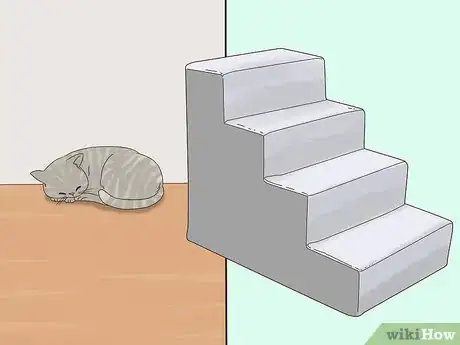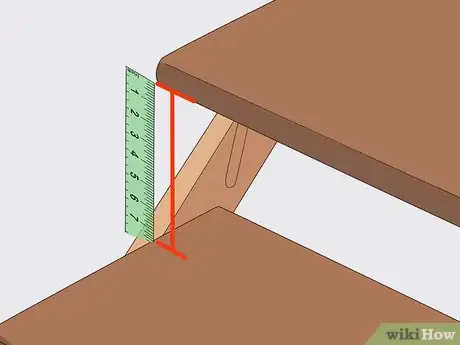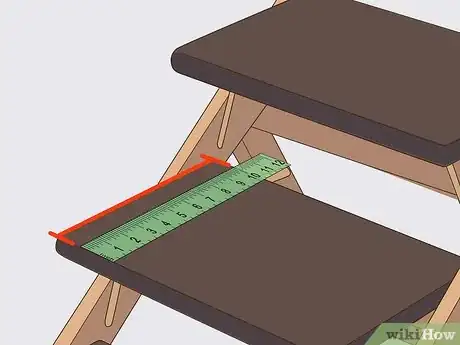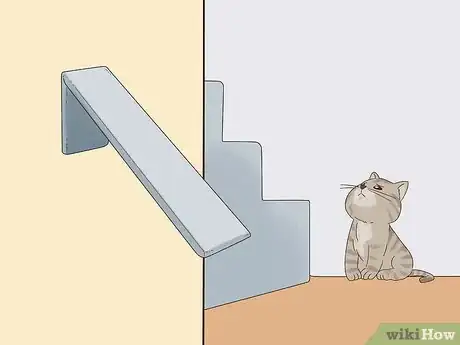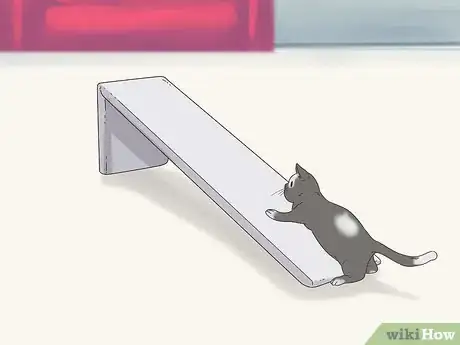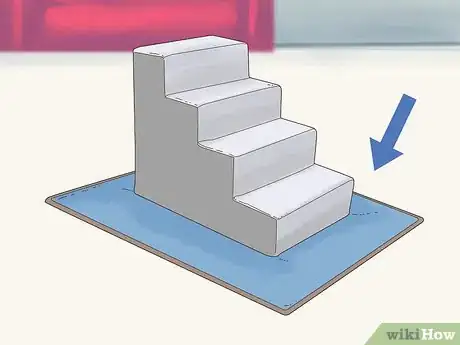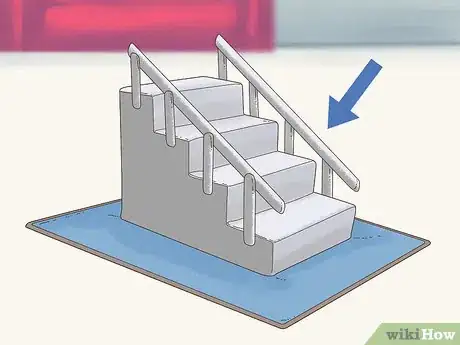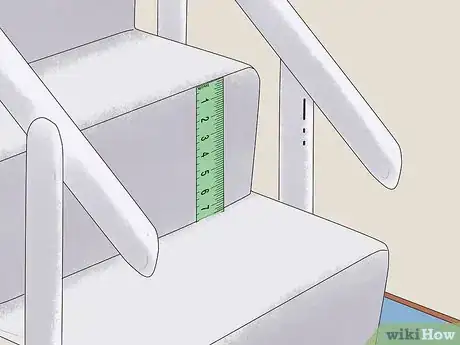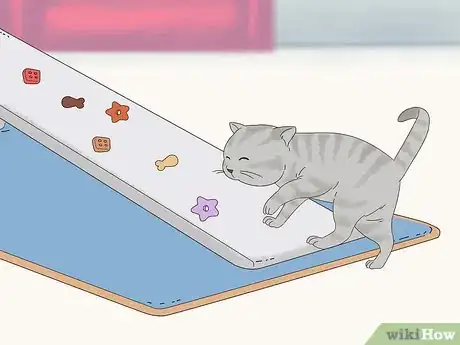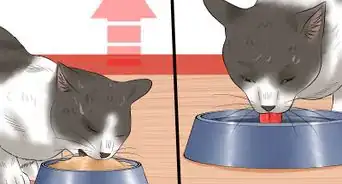This article was co-authored by Ryan Corrigan, LVT, VTS-EVN. Ryan Corrigan is a Licensed Veterinary Technician in California. She received her Bachelor of Science in Veterinary Technology from Purdue University in 2010. She is also a Member of the Academy of Equine Veterinary Nursing Technicians since 2011.
This article has been viewed 32,875 times.
Cats hide their health problems, so you often need to be attentive to small changes. When you notice that your cat is no longer jumping to its favorite perches, it may become necessary to offer a helping hand. Ramps and stairs can make it easier for your cat to reach its favorite spots as it approaches old age. Stairs are a great starting point for cats who don’t like to jump anymore, but as walking becomes painful, a ramp will become necessary.
Steps
Purchasing Stairs
-
1Purchase stairs when your cat begins to avoid high places. Stairs are a great option for cats who find it uncomfortable to jump high but otherwise get around well. Cats like to hide illness, so you will need to watch attentively. If your cat suddenly starts to avoid high perches that it had once loved, then it might be time for stairs.[1]
- Your cat might have a problem if it has begun to avoid its cat tree. Also consider stairs if it has begun to sleep on the ground. Most cats prefer to sleep in a high perch.
-
2Purchase stairs to conserve space. Stairs take up less space than ramps. You can even buy stairs that are collapsible or easily transportable, so that you can put them away or move them if necessary. They have a steeper incline and thus are not as long. If your cat can manage stairs, it might be the more convenient option than a ramp.[2]Advertisement
-
3Look for steps no taller than 7 ½”. Each individual step should be no more than 7 ½” or 19 cm tall. This should be a comfortable height for your cat to climb. A steeper incline could make it hard for your cat to use the stairs.[3]
-
4Look for stairs at least 10” deep. Your cat likes to have space to maneuver on the step. Be sure that the steps are each at least 10” (25 cm) deep. Dogs are less interested in this space, so stairs designed for them might not have the depth required for cat stairs.[4]
Purchasing a Ramp
-
1Purchase a ramp if your cat has trouble walking. Stairs are great for cats who can’t jump high but can otherwise get around well. When you suspect that your cat is beginning to have trouble even walking around, then it is time to move on to a ramp. It usually helps to get cats accustomed to ramps ahead of time, so consider buying them when your cat first experiences mobility problems.[5]
- Cats like to hide their ailments, so it might be hard to tell when it begins to have mobility issues. By 15, you cat is likely to have some discomfort walking. Watch for changes in its gait. Look for signs that it is walking less or using less stairs less frequently.
-
2Purchase a ramp if your cat has never used stairs. Some cats never take to stairs and will be especially unlikely to use stairs if you introduce them to your cat late in life. If you cat has traditionally avoided stairs or has never had a chance to use them before, a ramp might be a safer bet.[6]
-
3Get a gentler slope for struggling cats. A slope of 18 degrees might be necessary for cats with a very severe impairment. For those with only moderate difficulties, something as steep as 26 degrees might be appropriate.[7]
Taking Safety Precautions
-
1Choose a model with non-looping carpet. Carpet is optimal because it provides traction and prevents your cat from slipping off. However, your cat’s nails can get stuck in carpet that has small loops. Try a non-looping carpet like plush.[8]
-
2Buy a model with safety rails. There should be rails along the side of the stairs that will stop your cat if it begins to fall off. This is especially important if your cat is losing its sight; it might be the only way that it knows where it is going.[9]
- If your cat loses its vision slowly, it will probably be hard for you to recognize the problem. Your cat will memorize the location of items in the household and act as if nothing has changed. However, it will bump into furniture more often than it used to, especially when you move furniture around. It might also seem more reticent to jump from high spots.[10]
-
3Be sure that the model is tall enough. The top step of stairs should be no less than 7 1/2” (25 cm) shorter than the surface it leads up to. A ramp should be high enough to be level with the surface.
-
4Choose a low-lying ramp or stair for cats with mobility problems. If your cat is older or if it has difficulty moving, try to keep the cat low to the ground in case it falls. Get a ramp for a couch, bed, or chair, but do not get ramps for windows, high perches, closet shelves, or bookcases.
-
5Place treats on the ramp to encourage your cat to use it. Your cat may not start using the ramp right away. To help it get used to the ramp, put a treat in middle of the ramp or stair. Once it is on it, put another treat on the top of the ramp. This will teach your cat how to get up using the ramp or stair.
- Give your cat plenty of time to get used to the ramp. Even with treats, your cat may not want to use it right away.
References
- ↑ http://www.petclassics.com/Service/pet-steps-or-ramps.1.html
- ↑ http://www.petclassics.com/Service/pet-steps-or-ramps.1.html
- ↑ http://www.petclassics.com/Service/indoor-pet-ramps.7.html
- ↑ http://www.petclassics.com/Service/pet-steps-or-ramps.1.html
- ↑ http://www.petclassics.com/Service/pet-steps-or-ramps.1.html
- ↑ http://www.petclassics.com/Service/pet-steps-or-ramps.1.html
- ↑ http://www.petclassics.com/Service/indoor-pet-ramps.7.html
- ↑ http://www.petclassics.com/Service/indoor-pet-ramps.7.html
- ↑ http://www.petclassics.com/Service/indoor-pet-ramps.7.html
About This Article
If you have an older cat that doesn't like to jump anymore, you may want to purchase a ramp or stairs for it to use, keeping in mind that stairs are better if you need to save space. For the optimal staircase, check that each step is no taller than 7.5" and at least 10" deep, so your cat has room to maneuver. However, if your cat has trouble walking or has never used stairs before, a ramp with a gentle slope of 18 to 26 degrees may be easier for it to use. Regardless of which option you choose, make sure to place your stairs or ramp on a non-slip rug or carpet to increase your cat's traction when climbing and prevent it from slipping and falling. For more advice from our Veterinary co-author, including how to encourage a cat to use a ramp or stairs, scroll down!
